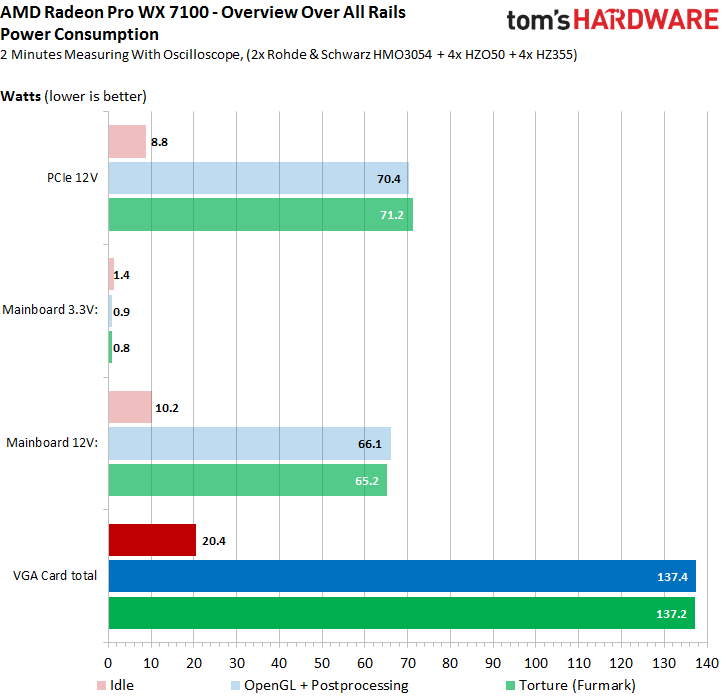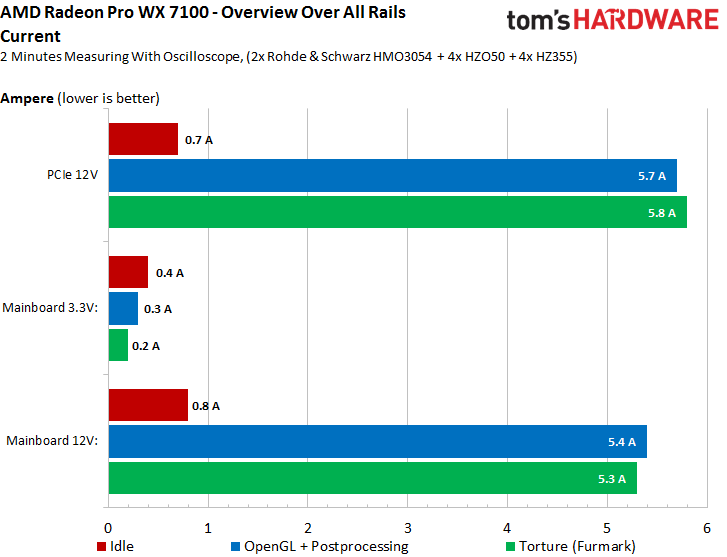AMD Radeon Pro WX 7100 Review
The FirePro brand is dead; long live the Radeon Pro. AMD puts its Polaris chips and reworked drivers to work in three new workstation graphics cards. We’re about to give the fastest model, the Radeon Pro WX 7100, a real workout.
Power Consumption
Measurement Methodology and Graphical Representation
In addition to the high-resolution measurement curves we normally present, we're adding a second, more reader-friendly look at the same data using significantly longer intervals supplemented by a hardware-based low-pass filter and a variable filter in the evaluation software. This helps identify short power spikes (and troughs) without bombarding you with all of the raw data.
If you want to know more about how we test and the equipment we use, check out The Math Behind GPU Power Consumption And PSUs.
Compared to previous features, our evaluation hardware hasn't changed:
| Power Consumption | |
|---|---|
| Test Method | Contact-free DC Measurement at PCIe Slot (Using a Riser Card) Contact-free DC Measurement at External Auxiliary Power Supply Cable Direct Voltage Measurement at Power Supply |
| Test Equipment | 2 x Rohde & Schwarz HMO 3054, 500MHz Digital Multi-Channel Oscilloscope with Storage Function 4 x Rohde & Schwarz HZO50 Current Probe (1mA-30A, 100kHz, DC) 4 x Rohde & Schwarz HZ355 (10:1 Probes, 500MHz) 1 x Rohde & Schwarz HMC 8012 Digital Multimeter with Storage Function |
Power Consumption Idle Mode
We had to re-run the first test a second time to confirm our measurements: a reading of almost 34W at idle is ludicrous. In our launch coverage, AMD's Radeon RX 480, based on the same GPU, used just 16W. A GPU clock rate of 300 MHz eliminated that as the source of this inflation. Ultimately, the cause was determined to be memory operating at full speed.
Update: Troubleshooting the Driver
After working with AMD post-review to reproduce this issue, it no longer occurs under the latest driver. We therefore updated the old idle measurements with new values. Power consumption at idle dropped to 20 watts, which is still higher than the Radeon RX 480, but much better than before.
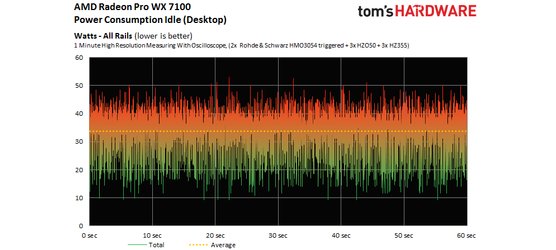
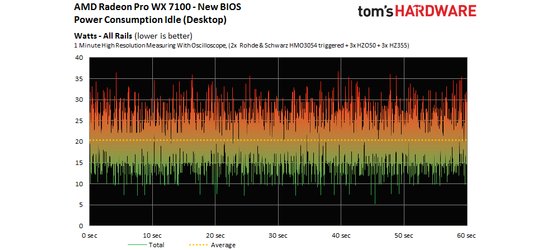
A different picture emerges after dividing total consumption into individual rails. Under the old driver, draw from the motherboard slot is particularly high, since that's where the memory gets its power.
Get Tom's Hardware's best news and in-depth reviews, straight to your inbox.
Old Driver:


New Driver:
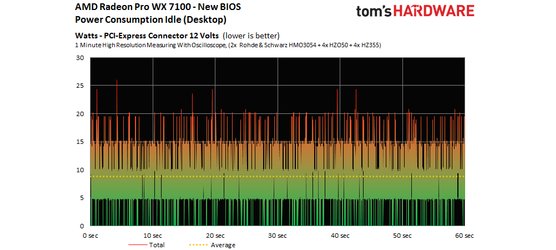

Considering where each power phase is connected, it becomes pretty clear that the additional consumption is attributable to the memory. In fact, we detected wild swings in frequency, with the old driver spending most of its time at 1750 MHz and only sporadically throttling down. This is fixed with AMD's new driver.
Power Consumption Under Different Load Scenarios
At the start of this review we noted the Radeon Pro's restrictive power limit that tried to keep the card below its 130W ceiling. Demanding workloads appear to be pegged at 137 watts without any room to push higher, which is good.
Power Supply Connection Loads
This high-resolution view of a one-minute measurement includes data for each rail. It includes all peaks and valleys, illustrating how quickly Power Tune can respond. The new driver has no influence on these results; the values from both builds are approximately the same:
But the spikes may cause more confusion than they need to. For this reason, we're only using the lower-resolution charts with a variable low-pass filter applied for our analysis.
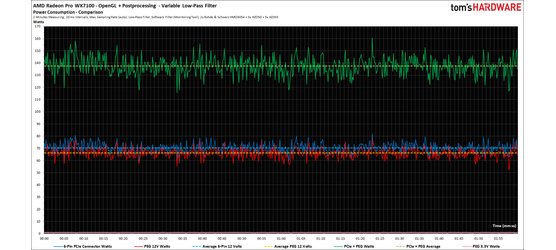
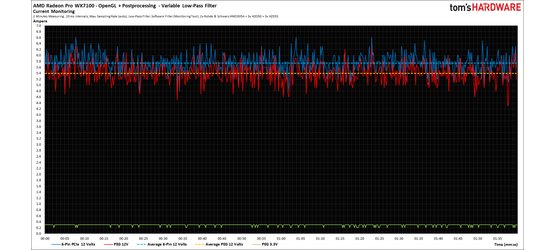
The balance between the motherboard's and six-pin power connector's 12V rails is important to us. Given what we previously observed about how each power phase is fed, the results match well. These graphs now reflect measurements from the new driver, replacing our findings from the original launch.
The 137-watt limit we mentioned earlier is slightly higher than the 130W typical board power cited on AMD's webpage. This ceiling comes partly from the motherboard's 66W power delivery, which is close to what the PCI-SIG considers to be this connection's maximum. The oft-cited 75W limit is incorrect, since it's the product of a 5.5A peak and the ATX's standard's supply voltage (this can be slightly higher than 12V).
Adding current measurements to our test suite allows us to confidently assert that the Radeon Pro WX 7100 remains within AMD's specifications, even when it's pushed hard.
The Radeon RX 480's maximum power consumption seems a bit high for a mainstream product. But the workstation-class Radeon Pro WX 7100 is more reasonable. Solid performance through our real-world benchmark suite and closer proximity to Ellesmere's sweet spot make WX 7100 a more efficient product.
Current page: Power Consumption
Prev Page Performance Benchmarks Next Page Clock Rates, Temperature & Noise
Igor Wallossek wrote a wide variety of hardware articles for Tom's Hardware, with a strong focus on technical analysis and in-depth reviews. His contributions have spanned a broad spectrum of PC components, including GPUs, CPUs, workstations, and PC builds. His insightful articles provide readers with detailed knowledge to make informed decisions in the ever-evolving tech landscape
-
xenol Why can't cards of this design make it to the consumer market? I'm sure there are lots of people yearning for a single-slot cooler card.Reply
On that note, it's ridiculous that AIBs slap on a two-slot cooler on lower end cards. -
Rookie_MIB The reason why it's single slot is simple enough, when you're looking to cram as much compute performance as possible in a computer, the slot spacing matters. There are some workstations which are ATX based which have 7 PCIe x 16 (or x8 after PLX switching) capable slots. As long as the cards can reliably remain below their temp threshold - that's all that matters.Reply
With a gaming style cooler (dual slot) it reduces the amount of compute performance without really increasing the speed as much. For example. If with a dual slot cooler, you can increase the core/VRAM speed 25-50% (because power usage increases exponentially with speed), that doesn't compare with being able to increase the compute by 100% by adding a second card. -
SliSpitfire 3.5 dB(A) more IS actually more than twice the perceived noise (logarithmic scale).Reply -
Virtual_Singularity Thanks for the review. They're a great value for their price. One of the biggest changes at AMD since last year, and especially within the past 6 months or so, has been the increased attention to driver optimization for their dGPUs. Their enterprise-oriented cards also benefit. The coolers on these single slot cards may not be the greatest, but for their intended use they're fine.Reply -
FormatC The price is the best argument. But let's also wait for next Sunday/Monday.Reply
Nvidia will show on their booth (Solidworks World) the new Pascal Quadro lineup.
It's under NDA until next week, but I have the most of this cards already in my hands.
I plan a showdown after this NDA with all available cards from AMD and Nvidia
in real-world applications. I'm sure, the price of the WX7100 will help to survive,
also after the launch :)
The WX4100, 5100 and 7100 are here, also the Quadro P5000, P6000 and a few
not launched cards ;)
BTW:
The Quadro P6000 beats the Titan X Pascal in Gaming. I tried it with Resident Evil 7
in 4K and Shadow Cache On. Impressive, but expensive. :D
The WX7100 is from my sight the better RX480. Closer to the sweet spot and more
efficient. And only marginally slower. The RX480 is the result of the stupid arms race
against the GTX 1060 and might be more interesting without such high clicks/voltages.
Just sitting on a RX480 roundup with up to eight cards and some cards takes more than
200 Watts in gaming loops. This is simply too much for a few FPS more.
Polaris is not bad, if the chips are used as constructed. All stronger OC is mostly painful.
-
shrapnel_indie Reply19247867 said:3.5 dB(A) more IS actually more than twice the perceived noise (logarithmic scale).
Actually, 3 dB isn't perceived as twice as loud. you need 10 dB for that.
http://www.noisehelp.com/decibel-scale.html
http://www.acousticsbydesign.com/acoustics-blog/perception-vs-reality.htm
http://www.siue.edu/~gengel/ece476WebStuff/SPL.pdf (Page 5) -
TJ Hooker Reply
It would be ~twice the power, but human perception of sound is not linear with power.19247867 said:3.5 dB(A) more IS actually more than twice the perceived noise (logarithmic scale). -
bak0n Reply19247750 said:Why can't cards of this design make it to the consumer market? I'm sure there are lots of people yearning for a single-slot cooler card.
On that note, it's ridiculous that AIBs slap on a two-slot cooler on lower end cards.
RX460 is now out as a single slot card. But yes, I agree with you. -
FormatC I like the low-profile cards, because I have a lot of very small ITX-cases with no space inside :)Reply




